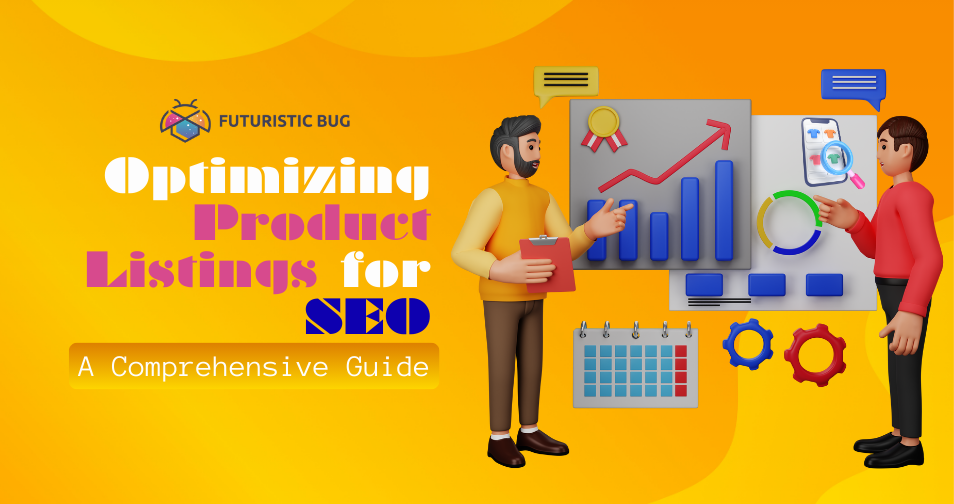E-commerce is the fastest-growing, dynamic, and absolute future of retail business. Over half of internet users use various e-commerce sites to run their daily errands. For its obvious user benefits ecommerce is getting its popularity among the mass. It helps this industry to generate massive revenue each year. Many business giants and small-timers dive into this industry to achieve their goals. Generally, the competition is getting tougher day by day. You can start your journey with the help of an e-commerce web development company.
However, if you are also thinking of investing in the ecommerce sector you need to be ahead of your competition. For this purpose, you need to strategize your SEO game dynamically. There are many things that you can try to make your SEO game strong. One of the most important things is optimizing product listing.
In this blog, we will discuss various things related to the optimization of product listing for SEO. Be with us and learn to ace your SEO game for your e-commerce business.
Benefits of optimizing your e-commerce website’s product listing for SEO
Optimizing your e-commerce website’s product listings for SEO (Search Engine Optimization) offers numerous benefits. These include increasing visibility, attracting quality traffic, improving user experience, and ultimately driving sales and revenue for your business. It can have a profound influence on your online business.
Some of the key advantages are written below.
Increased Visibility and Traffic
SEO optimization helps your products rank higher in search engine results pages (SERPs). This increased visibility leads to more organic traffic to your website as users are more likely to click on the top search results.
Better User Experience
SEO optimization often involves improving website structure, navigation, and overall user experience. When users can easily find what they’re looking for, they’re more likely to stay on your site longer and make a purchase.
Credibility and Trust
Users tend to trust and find websites more credible when they appear at the top of search results. SEO optimization can enhance your online reputation and make users more likely to trust your brand.
Higher Conversion Rates
When your product listings are optimized for relevant keywords and provide valuable information, visitors are more likely to convert into customers. Optimized product descriptions and images can persuade users to make a purchase.
Competitive Advantage
If your competitors are optimizing their product listings and you’re not, they’re more likely to attract potential customers. SEO optimization allows you to stay competitive and even outperform your rivals in search rankings.
Mobile Optimization
With the increasing use of smartphones, many people shop online using mobile devices. SEO optimization often includes mobile-friendly design, ensuring that your e-commerce site is accessible and easy to navigate on various devices, leading to better rankings in mobile search results.
Insights into Customer Behavior
SEO tools and analytics provide valuable insights into customer behavior, including what keywords they use, what products they search for, and how they interact with your website. This data can be used to make informed business decisions and tailor your marketing strategies.
Cost-Effectiveness
Organic traffic from SEO is cost-free in contrast to paid advertising. While SEO requires an initial investment, the long-term benefits often outweigh the costs, providing a cost-effective way to drive high-quality traffic to your website.
Local SEO Benefits
If you have a physical store, optimizing your product listings for local SEO can attract local customers to your brick-and-mortar location, increasing foot traffic and sales.
Adaptability
SEO strategies can be adapted and refined based on changing market trends and customer behavior. This flexibility allows you to stay relevant and adjust your approach to meet the evolving needs of your audience.
In summary, optimizing your e-commerce website’s product listings for SEO is essential for increasing visibility, attracting quality traffic, improving user experience, and ultimately driving sales and revenue for your business.
Guide to Optimizing Product Listing For SEO
Optimizing product titles and descriptions for search engines is a crucial component of e-commerce SEO. By effectively optimizing your product listings, you can increase their visibility in search results, attract more traffic, and potentially boost your sales.
Let’s explore various strategies and best practices for optimizing your product listings for search engines.
Keyword Research and Selection
a. Research Relevant Keywords
- Start by identifying keywords that accurately describe your products.
- Use tools like Google’s Keyword Planner or Ahrefs to find popular and relevant keywords in your niche.
- Select keywords that have a reasonable search volume and align with your products.
b. Long-Tail Keywords
- Consider incorporating long-tail keywords into your listings. These are specific phrases that are less competitive but can attract highly targeted traffic.
- For instance, instead of “red sweater,” use “women’s red cashmere sweater” for a more specific audience.
Product Title Optimization
a. Use Relevant Keywords
- Include primary keywords in your product title.
- Be specific and descriptive; use terms commonly used by potential customers.
b. Keep It Concise
- Aim for around 50-60 characters for your product title.
- Provide key product information in a concise manner.
c. Include Brand and Key Features
- Incorporate the brand name and essential product features in your title.
- This helps differentiate your product and provides context.
d. Use Modifiers
- Include modifiers like “best,” “top,” and “reviews” to stand out in search results.
Product Description Optimization
a. Concise and Informative
- Keep product descriptions concise (around 150-200 characters) while providing essential details.
- Highlight key features and benefits with bullets.
b. Call-to-Action (CTA)
- Include a CTA in your product description, encouraging customers to take action, such as “buy now” or “add to cart.”
c. Unique and Compelling
- Avoid using the same descriptions as competitors.
- Craft unique and engaging meta tags to set your products apart.
Image Optimization
a. Descriptive File Names
- Give relevant file name to the product image.
- For example, “red-canvas-sneakers.jpg” instead of generic names like “image001.jpg.”
b. Alt Text
- Include descriptive alt text for images, aiding both search engines and visually impaired users.
c. High-Quality Images
- Use high-resolution images showcasing your products from various angles.
- Enable zoom functionality for users to examine products closely.
d. Responsive Images
- Ensure images adapt to different device sizes for a seamless user experience.
e. Image File Types
- Choose appropriate file types (e.g., JPEG for photos, PNG for transparency).
- Maintain consistency in file types across your product images.
Schema Markup for Product Listings
a. Product Schema
- Implement Product schema to provide detailed product information, such as name, price, availability, and reviews.
b. Offer Schema
- Use Offer schema to showcase promotions or discounts on your products.
c. Rich Snippets
- Implement structured data to display pricing and ratings directly in search results.
Mobile Optimization
a. Responsive Design
- Ensure your website and product listings are responsive, and adapting to various device sizes.
b. Clear and Concise Descriptions
- Craft concise product descriptions suitable for mobile users with limited screen space.
c. High-Quality Images
- Optimize images for mobile devices, maintaining image quality and fast loading times.
d. Mobile-Friendly Navigation
- Implement mobile-specific navigation, including large buttons and user-friendly menus.
A/B Testing for Continuous Improvement
a. Test Titles
- Conduct A/B tests to compare different product title versions and identify the most effective ones.
b. Test Images
- A/B tests various product images to determine which ones attract more clicks and conversions.
c. Test Pricing Strategies
- Experiment with different pricing strategies to see which ones drive higher sales.
d. Test Descriptions
- A/B test product descriptions to find the most compelling and informative versions.
Measuring and Tracking Success
a. Key Metrics
- Monitor important metrics like click-through rate (CTR), conversion rate, sales, average order value, customer reviews, and keyword ranking.
b. Analytics Tools
- Utilize analytics tools such as Google Analytics to track user behavior and measure the performance of your product listings.
c. Set Goals and Benchmarks
- Establish clear goals and benchmarks for your product listing optimization efforts.
d. Continuous Improvement
- Regularly analyze data and make adjustments to your product listings to improve their performance.
Summing Up
Optimizing product listings for SEO is a dynamic process that involves various operations. You might feel overwhelmed by these complications. For that, you must opt for an SEO agency to help you in the process.
By following these comprehensive strategies and best practices, you can enhance the visibility of your products in search results, attract more potential customers, and increase your e-commerce sales.
Remember that SEO is an ongoing effort, and staying updated with industry trends and user preferences is essential for long-term success. You need to hire experienced SEO experts for the job.




